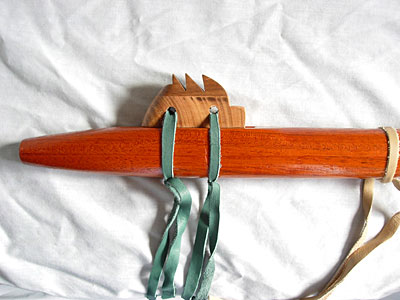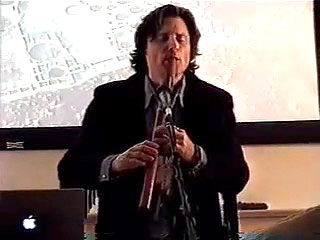
Last June I gave my first Native American flute class here in southern California. People came from all over the area but one person drove all the way from Tucson, Keith Stanford. At the time I thought this was a long way to come for a flute class but I'm glad he did. Why? Well, after the class ended and I was packing up I heard my friend, Barry, playing a flute behind me. I really thought the sound was unique. It was warm and mellow, yet strong and focused. As I turned around to check out the flute, Barry pointed to Keith who was standing next to him, and announced "Keith made this flute!". I knew immediately I wanted one of his flutes.
Like many good flute makers Keith Stanford does not make flutes full time, it is his hobby, so it took a couple months to get a flute from him. But he didn't just send me one flute, he sent me three and told me to pick the one I liked the best. They were all in F and all of them had that same sound I had heard back in June. One was made of Rosewood, one of Purpleheart, and one of African Padduk. After going back and forth over which one like liked the best, I finally made my pick, the Rosewood.
The flute

This flute is 23 1/2" long with a 1" bore. The body is made of Rosewood. Rosewood is a general term and refers to many richly colored woods, mostly brown. All rosewoods are strong, being a hard wood. The most widely know is Brazilian, or Rio rosewood, that was once highly sought after for acoustic guitar construction and fret boards.
The name rosewood comes from its strong, sweet, lingering scent. Because of this in the 1920's it became one of the ingredients for Channel No. 5. The use of Rosewood in fragrances, soaps, and guitars lead to overexploitation and the wood became endangered. It is now protected by CITES (Convention on International Trade in Endangered Species of Wild Fauna and Flora) and is very carefully controlled and hard to obtain.
Other rosewoods used for musical instruments are Cocobolo, for Native American flutes, we've looked at one made by Yazzie flutes, and Honduras rosewood for Marimbas and xylophones.

The block is in the form of an abstract Javelina and is made of two woods, Walnut on top and Hickory on the bottom.
This flute has that wonderful sound that I first heard back at my flute class.
Listen to a sample of this flute.
EARTH & SKY

The tone of this flute is so nice I've started playing it during concerts for the song Earth & Sky, from my second CD Sacred Dreams. That version was recorded using a Woodsongs flute. In November of last year I gave a concert in Tucson, AZ and just for fun I decided to play flutes made only by Arizona makers: J.P. Gomez, Mike Gulino, Pat Haran, Richard Maynard, Keith Stanford, Ed Pendrys and others. I performed Earth & Sky on Keith's flute and the recording made of that performance came out well enough that I've posted it in both audio and video formats on cedarmesa.com. It's available to everyone on my E-mailing list. Joining the list is free and you can do it Here.
Keith's Native American flute making Manual
Although Keith doesn't make a lot of flutes as it's his hobby, he has written a book for those that do: the "Ki-e-ta Native American Style Flute Manual". This manual is very popular with beginning and more advanced flute makers. Keith is an engineer by profession and brings that detailed analyzes to his work. I have met people that use his manual who are very pleased with the results and speak very highly of it. I have also played some flutes made using the Ki-e-ta manual as a guide, and they all sounded very pleasing.



Keith says that "No prior Woodworking experience necessary and you don't need to have a lot of tools". He has also included over 40 pictures to make each step clear.
Keith lives in Tucson, and is a member of the Tucson flute circle.
To find out more information about Keith Stanford and other flute makers check out the Flute Makers page on my web site.
If you want to read more posts about other Native American flute makers visit my Blog index.
More information
For a more detail look at the construction of the Native American flute read the History and Construction article on www.cedarmesa.com.
Comments
Let me know if you enjoyed this post. Leave a comment below.
Do you have a flute by any of the Makers we have looked at so far? If so let me know what you think of it.
Scott August